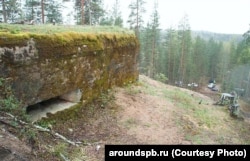ST. PETERSBURG, Russia -- The forested landscape of Russia's Karelia is dotted with a necklace of decaying concrete bunkers stretching from the Gulf of Finland to the shores of Lake Ladoga.
During World War II, the defensive line held back the Finnish Army, which participated with the Germans in the 900-day siege of Leningrad. But now, environmentalists say, it presents a serious danger: radioactivity.
The St. Petersburg branch of the Bellona environmental NGO has measured radiation in some of the bunkers at more than 1,000 times background levels. The levels of radiation from alpha particles exceeded the limits of their detection equipment -- 30,000 particles per square centimeter per minute.
"There was no electricity in the bunkers, so they installed panels with fluorescent paint that would shine for many years," said Aleksei Shchukhin, a Bellona specialist on radiation. Now those panels have become a problem.
The bunkers -- part of the so-called Stalin Line -- were built in the 1920s and 1930s but were modernized in the 1950s. Abandoned in the 1990s, the bunkers attract hikers, history buffs, children playing soldier, and homeless people. Some of them have been used as the foundations for homes. Others are used to store preserved fruits and vegetables.
I decided to take the [radiation] detector as long as I happened to have it with me. And we were in for a very unpleasant surprise."-- Activist Anton Kolomitsyn
Bellona estimates that tens of thousands of people have visited the bunkers since the military pulled out. There are about 230 of the bunkers, but it remains unknown how many of them are irradiated.
The potential danger was first discovered by chance late last year, when members of a volunteer organization called North-West, which searches for human remains and artifacts from the war, visited a bunker to take some photographs.
"We went there with the head of North-West, and I thought I would grab my radiation detector, which I happened to have in the car," Anton Kolomitsyn, the North-West activist who first discovered the radiation, told RFE/RL's Russian Service. "People are always climbing around in those bunkers, including myself, so I decided to take the detector as long as I happened to have it with me. And we were in for a very unpleasant surprise."
Ironically, North-West activists used to lead excursions to visit the bunkers for history enthusiasts.
Although the activists have raised the alarm, local and military authorities have been slow to react. Officials say the bunkers are not emitting radiation into the environment.
But environmentalists say officials are ignoring the many people who are exposed to high levels of radiation inside the bunkers.
"All of these bunkers are open," activist Shchukin said. "They are accessible to children and all the other residents of Leningrad Oblast. People go there without knowing the danger. There are no signs that these are radioactive objects. They are not closed."
Sergei Gribalyov, head of the testing laboratory of the Leningrad Oblast Legislative Assembly's Ecology Commission, told RFE/RL that his experts have confirmed Bellona's findings.
"I plan to ask the commission to authorize a complete study," Gribalyov said. "It is expensive work and it needs to be done by specialists. But I am pessimistic. Even though it is the Year of Ecology, there have been sharp cuts to all environmental programs and ecological projects. If we ask for money to decontaminate the bunkers, we will most likely encounter opposition."
For now, Gribalyov is placing his hopes on the local population, hoping that some nongovernmental organization will agree at least to help put up warning signs. Or even to pay to have the bunker doors welded shut.









